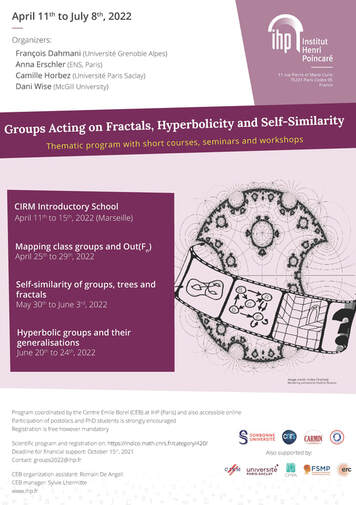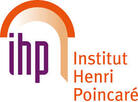|
4 videos available for this event!
|
|
CIRM-IHP PROGRAM
HYBRID RESEARCH SCHOOL / ECOLE DE RECHERCHE Groups Acting on Fractals 11 – 15 April 2022 Scientific Committee Indira Chatterji (Université Côte d’Azur) Organizing Committee François Dahmani (Université Grenoble Alpes) |
Rémi Coulon (CNRS, Université de Rennes) Growth and co-growth in negatively curved groups: a dynamical point of view Exercises
Anthony Genevois (CNRS, Université de Montpellier) Embeddings between RAAGs
Rachel Skipper (Ohio State University) Self-similar actions on Cantor sets Groups acting on (rooted) trees (slides) Exercises
Karen Vogtmann (University of Warwick) The geometry and topology of automorphism groups of free groups Exercises
|
Fractals play a key role in several topics in group theory. Many group actions have an intrinsically fractal nature. A prominent such scenario arises for a group acting on a tree when its restriction to a proper subtree is isomorphic to the original action. This is how Grigorchuk’s famous examples arise. Some groups have a boundary at infinity that is acompact fractal. This is the case for Gromov’s word-hyperbolic groups whose properties are reflected in the shape of this fractal boundary. Some groups are naturally related to dynamics of substitutions, leading naturally to fractalness of limit objects. This is the case for automorphism groups of free groups acting on the space of words, or automorphism groups of surface groups acting on the space of curves. We articulate our viewpoint of fractalness in group theory around these three topics: fractal groups acting on rooted trees, hyperbolic groups, and automorphism groups.
We chose these topics because they interact in interesting ways. Fractal groups are related to substitution dynamics, and so too are automorphisms of free groups. They often act on Gromov-hyperbolic spaces, and benefit from the framework of hyperbolic groupoids. Automorphisms of free groups or surface groups act on Gromov-hyperbolic spaces in ways that reveal their structure. The boundary of a hyperbolic group that is a free-by-cyclic semidirect product will reveal important information about its associated automorphism. Growth of discrete groups and orbits is also an important subject within each of these topics, and it too is related to fractalness. There has been an explosion of extraordinary developments here, including some recent breakthroughs answering long-standing open questions, but many profound questions remain unresolved. The knowledge and techniques at the state-of-the-art have become vast, involved, and powerful. A young community of researchers has emerged but sometimes quite specialized. The goal of our platform is to gather several subspecialties to consolidate knowledge, to coordinate interactions, and to prepare young researchers to develop the next stages in this field. A goal of the interactional environment we will foster, is to stimulate fruitful collaboration, deeper interfaces and interconnections between the topics, andvaluable mathematical cross-fertilization for future ventures of the participants. |
Les fractales sont au coeur de plusieurs facettes de la théorie des groupes. De nombreuses actions de groupes ont une nature fractale. Un exemple paradigmatique provient d’actions de groupes sur des arbres dont la restriction à un sous-arbre propre est isomorphe à l’action sur l’arbre entier. C’est là l’idée sous-jacente à la construction du célèbre groupe de Grigorchuk. Certains groupes ont une frontière à l’infini qui est un objet fractal. C’est le cas des groupes hyperboliques au sens de Gromov ; un grand nombre de leurs propriétés sont reflétées par la géométrie de cette frontière fractale. Certains groupes sont reliés à la dynamique de substitutions, et viennent donc naturellement avec un objet limite fractal. C’est le cas des groupes d’automorphismes de groupes libres agissant sur l’espace des mots, ou des groupes d’automorphismes de groupes de surfaces agissant sur l’espace des courbes. Notre point de vue sur la fractalité en théorie des groupes est articulé autour de ces trois
thématiques : les groupes fractals agissant sur des arbres enracinés, les groupes hyperboliques, et certains groupes d’automorphismes. Si nous avons choisi ces thématiques, c’est qu’elles ont, par plusieurs aspects, des interactions intéressantes. Les groupes fractals, tout comme les automorphismes de groupes libres, renvoient à la dynamique de substitutions. Ces groupes ont souvent des actions naturelles sur des espaces hyperboliques au sens de Gromov. Leur étude tire aussi avantage de la théorie des groupoïdes hyperboliques. Ainsi, les groupes d’automorphismes de groupes libres ou de groupes de surfaces ont des actions sur des espaces hyperboliques qui reflètent leur structure algébrique. La géométrie du bord d’un groupe hyperbolique qui est une extension de Zparun groupe libre est directement reliée à l’automorphisme du groupe libre associé. La croissance des groupes discrets et de leurs orbites est aussi un sujet important dans chacune de ces thématiques, et est aussi reliée à la fractalité. Ces différentes thématiques ont récemment fait l’objet de développements spectaculaires, avec la résolution de problèmes majeurs restés ouverts pendant plusieurs décennies. Toutefois, de nombreuses questions cruciales restent encore ouvertes aujourd’hui. À ce jour, les connaissances et techniques accumulées autour de ces thématiques sont nombreuses, pro-fondes et prometteuses. Une communauté de jeunes chercheurs a émergé, mais cependant certains restent assez spécialisés. Nous offrirons un cadre qui permettra de rassembler des experts issus de différentes sous-thématiques, afin de renforcer l’état des connaissances, de coordonner les interactions, et de former les jeunes chercheurs afin qu’ils puissent faire fructifier à l’avenir ce domaine de recherche. Nous favoriserons un environnement riche en interactions qui sera, nous l’espérons, le terreau de collaborations fructueuses, d’interfaces et d’interconnexions entre les différentes thématiques, et d’un enrichissement mathématique mutuel propice à la recherche future des participants. |






